Statewide Fisheries Research - Completed Projects and Reports
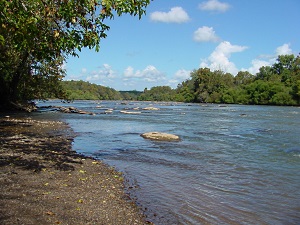
The goal of the Freshwater Fishery Research is to obtain relevant and sound information that improves the Department's
ability to manage and conserve the aquatic natural resources of South Carolina.
Downloadable documents below are in the PDF format.
Annual Progress Reports, with Index
Factors affecting fishery recruitment in the Santee-Cooper system
Lake Wateree Striped Bass Stocking Evaluation
- Distribution of Striped Bass in J. Strom Thurmond Reservoir, South
Carolina - Georgia, in Relation to Pump Storage Operation and
Hypolimnetic Oxygenation
-
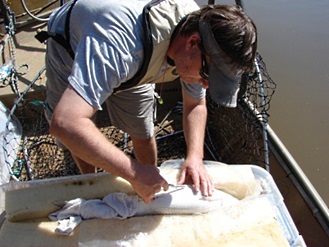
Thurmond Reservoir supports a popular recreational striped bass fishery that is known regionally for trophy striped bass production.
Trophy striped bass production at Thurmond is largely due to suitable habitat provided by artificially oxygenated, deep-water releases
from Russell Dam, that provide cool, well-oxygenated water in the tailrace. Thermal stratification of Thurmond Reservoir during the
summer leads to poor striped bass habitat throughout most of the reservoir, consequently striped bass congregate in the Russell Tailrace
where cool well oxygenated water provides a summer-time refuge. Increased pump-storage operations starting in 2011 at Russell Dam could
result in warmer water in the Tailrace, during some hydrologic conditions, and reduce Striped Bass habitat. To compensate for this
potential loss of habitat the US Army Corps of Engineers installed an oxygen injection system in the lower reservoir during 2011 to
create suitable striped bass habitat in the lower reservoir. An expansive hydroacoustic receiver array was deployed to monitor the
seasonal distribution and describe the summer habitat (i.e., temperature and dissolved oxygen) occupied by Striped Bass.
- Statewide Stream Assessment
-
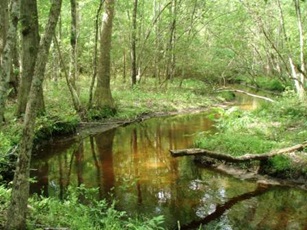
The condition of the surrounding landscape largely determines the biological health of the receiving stream. Therefore, effective
conservation of freshwater streams must include an approach that recognizes land and water resources as integrated parts of the same system.
The South Carolina Department of Natural Resources, in conjunction with Clemson University initiated a comprehensive assessment of South
Carolina's wadeable streams in 2006 to determine the status of native fish assemblages and aquatic resources throughout the state.
The assessment of nearly 500 streams was completed in 2011, with a collection of biological, chemical, physical, and corresponding
landscape data necessary to support proactive conservation planning of South Carolina's aquatic resources.
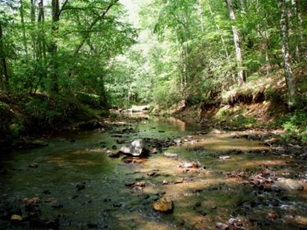
Downloadable files below are in PDF format.
Stream Assessment Publications
- Mussels and Crayfish
-
Smallmouth Bass Stocking
American Eel Abundance
Reedy River Oil Spill
Reedy River - Watershed Planning
Forage Needs of Brown Trout in Lake Jocassee
Movements of Striped Bass in Santee-Cooper
Stocking of Redear Sunfish
Water Quality of Public Fishing Lakes
- Lake Greenwood Fishery Habitat
-
Through a series of grants, factors affecting water quality in Lake Greenwood have been looked at. The
Lake Greenwood model report (PDF)
documents the development of a water quality model that was and can be used to predict how water quality would change when inflow
conditions – especially nutrient load - were changed. The Lake Greenwood model
supplement (Adobe PDF file) examines the affect of altering nutrient inflows from the Saluda River. The
Saluda-Reedy watershed report (PDF)
examines nutrient loading to Lake Greenwood from Saluda and Reedy river sources. The
Saluda-Reedy supplement (PDF)
estimates the relative contribution of point and non-point nutrient loads within the Saluda and Reedy river basins.
We hope that this information and the developed models can be used to conserve,
maintain, and, possibly, enhance the water quality of Lake Greenwood.
- Broad River Basin Inventory
-
A survey of the fish community of the Broad River was conducted in 2001-2002. This study was done to better define the composition and
the condition of the aquatic community, which will lead to more effective management of the natural resources. Ten sites along the entire
course of the river were sampled and 51 fish species were collected. The species most commonly collected were redbreast sunfish, whitefin
shiner, and silver redhorse. The growth of redear sunfish and redear sunfish was assessed. The growth and condition of largemouth bass was
evaluated. Eighty seven percent of the riparian habitat along the river was judged to be in good condition. An initial assessment of the
freshwater mussel community was also performed. The completed final report (PDF),
contains the detailed information obtained during this survey.
A survey of tributary streams of the Broad River was conducted in 2003-2005. The condition and diversity of the fish community was assessed
at 45 sites. During these surveys, a total of 45 fish species, 12 of which were of conservation concern, were collected. In addition to fish
community surveys, an examination of the macroinvertebrate community was conducted in 2005; a total of 323 different types were sampled. The
final report (PDF) displays, in detail, the information obtained from
this effort.
- Congaree National Park Inventory
-
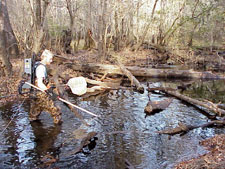
The Congaree National Park rests on a floodplain of the
Congaree River just
outside Columbia. The park preserves, in a wilderness state, the largest intact tract of old-growth bottomland hardwood forest
in the United States. The park boasts some of the tallest trees in the East with one of the highest canopies in the world. A
broad biodiversity gives the park recognition as an International Biosphere Reserve, a National Natural Landmark, a
Wilderness Area, and a "Globally Important Bird Area."
- Cooper River Ricefields
-
Conducted by James M. Long, Ph.D.
This multi-disciplinary work examines the role of vegetation as fish habitat on the structure and function of fish communities.
We are quantifying how fish communities relate to vegetation at the wetland scale and at the vegetation patch scale by comparing
wetlands that differ in vegetation composition and comparing among different vegetation types within wetlands. Furthermore, we are
quantifying the energy dynamics in these wetlands by examining secondary production of fish and the food habits of the top predator,
largemouth bass.





